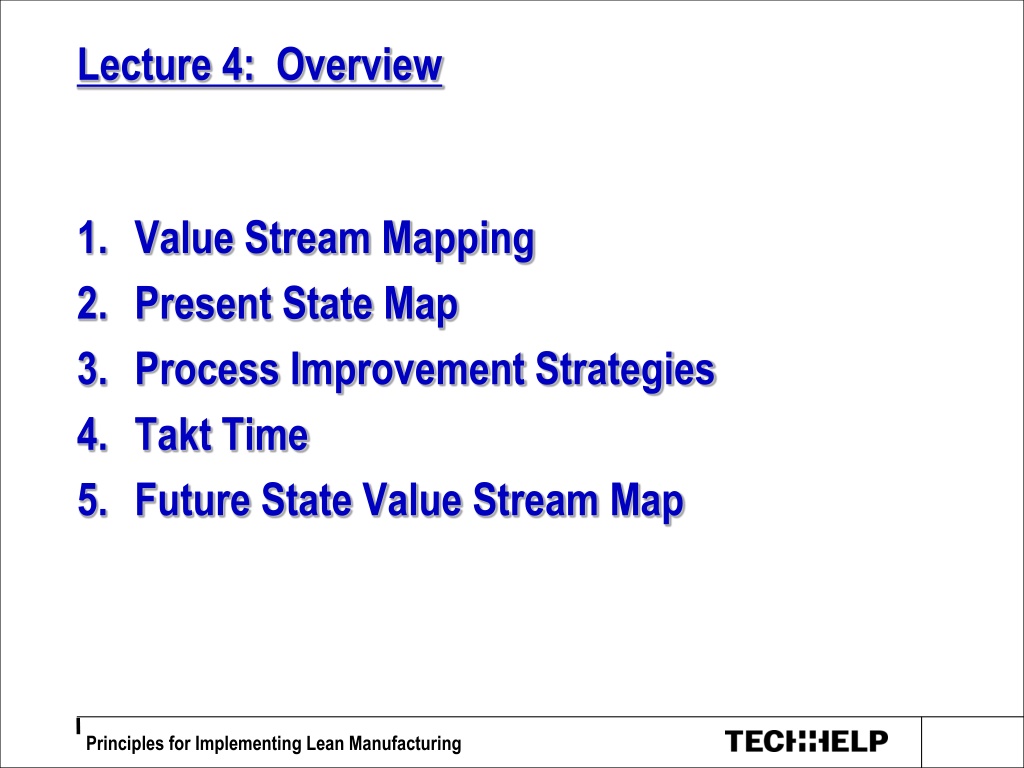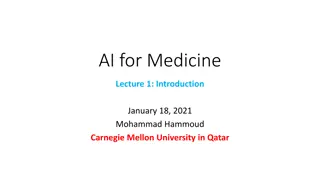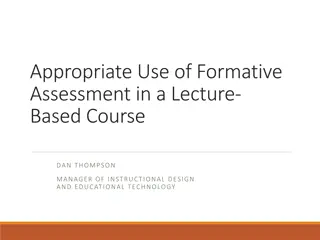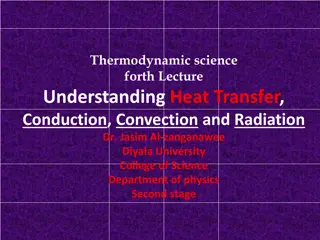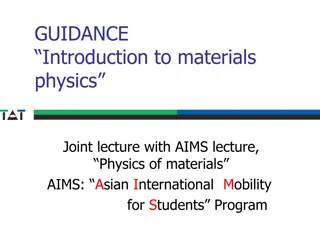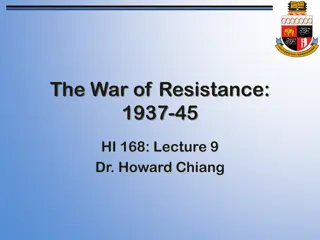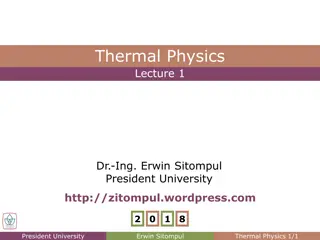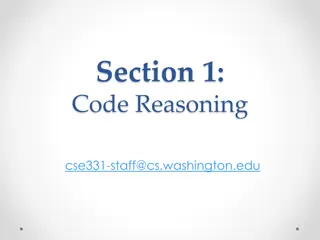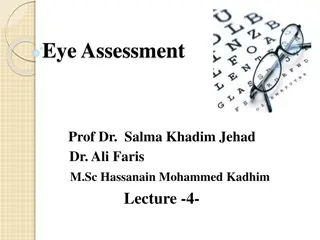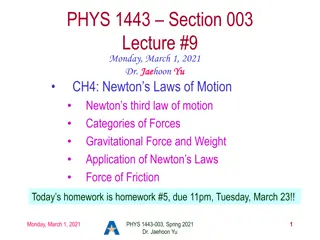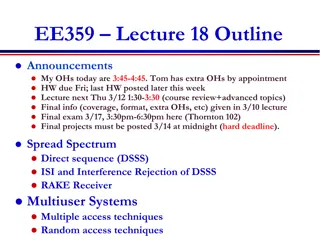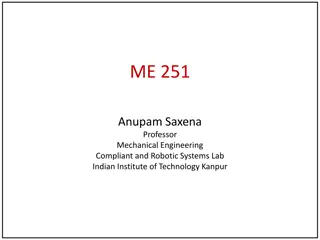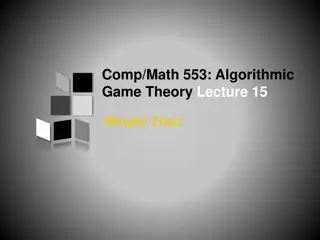Lecture 4: Overview
Value Stream Mapping helps identify value creation and waste in processes, utilizing present and future state maps. It highlights process improvement strategies, Takt Time, and principles for implementing Lean Manufacturing. The process box, data box, inventory triangle, push movement arrow, and lead time bars are key elements in analyzing and optimizing workflows.
Download Presentation

Please find below an Image/Link to download the presentation.
The content on the website is provided AS IS for your information and personal use only. It may not be sold, licensed, or shared on other websites without obtaining consent from the author.If you encounter any issues during the download, it is possible that the publisher has removed the file from their server.
You are allowed to download the files provided on this website for personal or commercial use, subject to the condition that they are used lawfully. All files are the property of their respective owners.
The content on the website is provided AS IS for your information and personal use only. It may not be sold, licensed, or shared on other websites without obtaining consent from the author.
E N D
Presentation Transcript
Lecture 4: Overview 1. Value Stream Mapping 2. Present State Map 3. Process Improvement Strategies 4. Takt Time 5. Future State Value Stream Map Principles for Implementing Lean Manufacturing
Value Stream Mapping Helps us see where value is created, and where waste exists: Developed by product family Shows flow of both material & information. Helps us see where/how specific Lean tools can be used to improve flow and eliminate waste Consists of two types of maps: Present State ( how it is ) Future State ( how it should be ) Value Stream Mapping
Present State Value Stream Map Value Stream Mapping
The Process Box Indicates basic production process. One box for each major material flow, not for each processing step. Process disconnection and inventory accumulation are indicators of where processes are separated. Value Stream Mapping
The Data Box The Data Box stores process information - Cycle Time (C/T). Rate at which a part or product is completed by a process. - Changeover Time (C/O). Amount of time to switch from one product type to another. - Uptime. Measure of machine use (100% = Always running). - Every Part Every (EPE). Measure of batch sizes and changeover cycles. - Available Work Time. Per shift of a process (in seconds, minus break, meeting, and cleanup times.) - Quality Level. % First time yield. - Number of Operators. Required personnel for a process. Value Stream Mapping
Inventory Triangle and Push Movement Arrow An Inventory Triangle captures the location and amount of inventory A striped arrow indicates a Push movement of inventory according to a predefined schedule Value Stream Mapping
Lead Time Bars Lead time indicates total time for a process or series of process. - Production/Manufacturing Lead Time (MLT). Lead time through entire production. - Process Lead Time. Lead time though each process, including time in inventory. Calculated as inventory quantity divided by daily customer requirement. - Processing Time = Value Added Time. Actual time spent processing the part or product. - Used to highlight inefficiencies (7000 pcs)/(28400 pcs/month)x(20 workdays/month) Value Stream Mapping
Present State Value Stream Map Value Stream Mapping
Map Features 1: Document customer demand 2: Define processes w/operation data 3: Show material flow 4: Show information flow 5: Compute lead times Value Stream Mapping
Questions Part 1 1. Are there any symbols on the map that you don t recognize? 2. What determines the work schedule at each station? 3. How is time data in the map acquired? 4. What is the bottleneck in the ACME manufacturing process? 5. Where is the biggest changeover time? What does this mean for downstream processes? Value Stream Mapping
Questions Part 2 1. What is the manufacturing lead time for a product (definition and value)? How does that compare to the value added time? 2. What is the impact of 1 truck a day leaving with finished goods and trucks arriving on Tuesday and Thursday with coils of steel? Value Stream Mapping
Questions Part 3 1. Where do you see waste in this process and what types of waste from the mnemonic CLOSED MITT do you see? 2. What countermeasures could be taken to reduce the most significant forms of waste? Value Stream Mapping
Mapping Methodology Focus on a product family within single plant. Seek leadership from the value stream manager. Go and see. Conduct door-to-door process walk. Work backwards, starting at the shipping door. Capture and quantify basic operations involved. Encourage participation of all stakeholders. Use pencil & paper rather than CAD. Value Stream Mapping
Investigation Etiquette Get management approval Communicate to all areas before visit Make introductions when you get there Remember, the workers are the experts for their tasks! Respect people s work space Explain your purpose Value Stream Mapping
Strategies for Process Improvement #1: Produce to your Takt Time. #2: Develop continuous flow where possible to reduce inventory. Eliminate isolated islands of production. #3: Use supermarkets to control production where continuous flow does not extend upstream (often outside the plant). #4: Try to send customer schedule to only one production process (pacemaker). #5: Load-level production at pacemaker. #6: Release/withdraw small, consistent increments of work to pacemaker (pitch). Value Stream Mapping
Establish Takt Time Synchronizes pace of production to match pace of sales. Takt Time = Demand Rate Work Time Available Number of Units Sold Takt Time = 900 Seconds 85 Boards = 10.6 Sec/Board Takt Time = Cycle Time Takt Time = Minimum # of People GOAL: Produce to Demand Value Stream Mapping
Supermarket Pull System Used to control production where continuous flow does not extend upstream. Example Reasons for Supermarkets: - Process that operate at very fast or slow cycle times and need to change over to serve multiple product families - Some processes, such as those at suppliers, are far away and shipping one piece at a time does not make sense. - Some processes have too much lead time or are too unreliable to couple directly to other processes in a continuous flow. Value Stream Mapping
Pacemaker Process A pacemaker process is single point in the manufacturing value stream that sets the production pace for the entire process. The pacemaker process is frequently the most downstream continuous-flow process. On the future-state map, the pacemaker process is the production process that is controlled by the outside customer s orders. Load-leveling means distributing the production of different products evenly over a time period, creating a product mix . The schedule should create an initial pull by releasing and withdrawing a small, consistent increment of work, called the Pitch . Value Stream Mapping
Load Leveling and Paced Withdrawl Load-leveling means distributing the production of different products evenly over a time period, creating a product mix . The schedule should create an initial pull by releasing and withdrawing a small, consistent increment of work, called the Pitch . Value Stream Mapping
Questions Part 4 1. What is the company s Takt time if the demand is 460 parts per 8 hour shift (with two 10 minute breaks)? 2. Where is it not practical to achieve continuous flow? How could a supermarket be used to overcome this? 3. How can the welding and assembly operations be configured to Takt time? 4. What should be the pacemaker process? 5. What other improvements are possible? Value Stream Mapping
Future State Value Stream Map Value Stream Mapping
